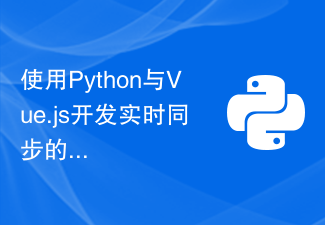The benefits of vuejs for development are: 1. Small size; 2. Higher operating efficiency; 3. It allows developers to no longer have to operate DOM objects and devote more energy to business logic; 4. Rich ecology; 5. Low learning cost.

The operating environment of this article: windows7 system, vue2.5.17 version, DELL G3 computer.
What are the benefits of vuejs for development?
vue framework (why use Vue, what are the benefits)
1. What is Vue.js
Vue is a progressive JavaScript framework for building user interfaces.
2. Advantages of Vue.js
- Small size: only 33k after compression;
- Higher operating efficiency: based on virtual DOM is a technology that can perform various calculations through JavaScript in advance to calculate and optimize the final DOM operation. Since this DOM operation is a preprocessing operation and does not actually operate the DOM, it is called virtual DOM;
- Two-way data binding: allows developers to no longer operate DOM objects and devote more energy to business logic;
- Rich ecology and low learning cost: There are a large number of mature and stable products in the market The UI framework and components based on vue.js can be used to achieve rapid development; it is friendly to beginners, easy to get started, and has many learning materials;
3. Why use Vue.js
With the continuous development of front-end technology, front-end development can handle more and more businesses, and web pages are becoming more and more powerful and dynamic. These advances are inseparable from JavaScript. In the current development, a lot of server-side code has been put into the browser for execution, which generates thousands of lines of JavaScript code, which are connected to various HTML and CSS files, but there is a lack of formal organizational form. This is also the reason why more and more front-end developers use JavaScript frameworks. Currently, the more popular front-end frameworks include Angular, Reac, Vue, etc.
Vue is a friendly, versatile and high-performance JavaScript framework that can help you create a more maintainable and testable code base. Vue is a progressive JavaScript framework, which means that if you already have a ready-made server application, you can embed Vue as part of the application to bring a richer interactive experience. Or if you want to implement more business logic on the front end, Vue's core library and its ecosystem can also meet your various needs.
Like other frameworks, Vue allows you to divide a web page into reusable components. Each component contains its own HTML, CSS, and JavaScript to render the corresponding place in the web page. If we build a large application, we may need to split things into separate components and files. Using Vue's command line tools makes it very simple to quickly initialize a real project.
vue init webpack my-project
We can even use Vue’s single-file components, which contain their own HTML, JavaScript, and scoped CSS or SCSS.
4, MVC, MVP, MVVM design pattern
MVC (Model-View-Controller) is one of the most common software architectures and is widely used in the field of software development. MVC itself is It is relatively easy to understand, but it is not easy to explain clearly the MVP and MVVM derived from it.
4.1, MVC
MVC means that the software can be divided into three parts:
- View: User Interface
- Controller: Business logic
- Model: Data storage
The communication method between each part is:
- View sends instructions to Controller
- After Controller completes the business logic, it requires Model to change state
- Model sends new data to View, and the user gets feedback
And all communication is one-way, as shown in the following figure:

There are two ways to execute the MVC mode:
(1) Accept instructions through View and pass them to Controller

(2) Accept instructions directly through Controller

Actual A more flexible approach is often used in projects:
(1) The user can send instructions (DOM events) to the View, and then the View directly requests the Model to change the state;
(2) The user can also Send instructions directly to the Controller (changing the URL triggers the hashChange event), and then the Controller sends it to the view;
(3) The Controller is very thin and only plays a routing role, while the View is very thick, and the business logic is deployed in View, so some frameworks directly cancel the Controller, leaving only a Router.
As shown in the picture:

4.2, MVP
MVP (Model-View-Presenter) evolved from the classic MVC. Mode provides data, View is responsible for display, and Presenter is responsible for logical processing.
There is a major difference between MVP and MVC:
- In MVP, the View and the Model are not connected. The communication between them is carried out through the Presenter, and all interactions are Happens inside the Presenter (that is, the Controller in MVC); in MVC, the View will read data directly from the Model instead of through the Controller.
- The communication between various parts in MVP is two-way, while the communication between various parts in MVC is one-way.
- In MVP, View is very thin and does not deploy any business logic. It is called "Passive View" (Passive View), that is, it does not have any initiative, while Presenter is very thick and all logic is deployed there.
As shown in the figure:

##4.3, MVVM
MVVM (Model-View-ViewModel), which is essentially an improved version of MVC, is a more detailed division of labor for View in MVC. ViewModel separates the view UI and business logic. It can take out the data of the Model and help process the business logic designed in the View due to the need to display content.
What is data-driven
Data-driven is the biggest feature of Vue.js. In Vue, the so-called data-driven means that when the data changes, the user interface changes accordingly, and developers do not need to manually modify the DOM. For example, when we click a button, the text of the element needs to perform a "yes/no" switching operation. In traditional jQuery, the process of page modification is usually: bind the event to the button, and then obtain The copy corresponds to the DOM object of the element, and finally the text value of the DOM object is modified according to the switch.Vue implements data-driven
Vue implements two-way data binding mainly through data hijacking, in conjunction with the publisher-subscriber model, throughObject.defineProperty () to hijack the setter and getter of each attribute, publish messages to subscribers when the data changes, and trigger the corresponding listening callback.
Understanding of getters and setters
When printing out the attributes in the data object under the vue instance, each of its attributes has two corresponding get and set method. As the name suggests, get is the value method, and set is the assignment method. Under normal circumstances, value acquisition and assignment are done using obj.prop, but there is a problem with this. How do we know that the value of the object has changed? We can understand get and set as functions. When we call the properties of the object, we will enter get.property(){...} and first determine whether the object has this property. If not, Then add a name attribute and assign a value to it; if there is a name attribute, then return the name attribute. You can think of get as a function that takes a value, and the return value of the function is the value it gets. When assigning a value to an instance, it will enter set.property(val){...}. The formal parameter val is the value assigned to the property. Many things are done in this function, such as two-way binding. etc. Because this value must go through set every time, the value cannot be modified in other ways. In ES5, the object prototype has two properties,_defineGetter_ and _defineSetter_, which are specially used to bind get and set to objects.
6.1 What is virtual DOM
The concept of Virtual DOM was introduced in Vue.js version 2.0. Virtual DOM is actually It is a tree structure that uses JavaScript objects (VNode nodes) as a basis to simulate the DOM structure. This tree structure contains information about the entire DOM structure. To put it simply, Virtual DOM can be understood as a simple JS object, and it contains at least three attributes: tag name (tag), attributes (attrs) and child element objects (children). Different frameworks will name these three properties differently.
6.2 The role of virtual DOM
The ultimate goal of virtual DOM is to render virtual nodes to the view. But if you directly use virtual nodes to overwrite old nodes, there will be many unnecessary DOM operations. For example, there are many li tags under a ul tag, and only one of the li tags has changed. In this case, if a new ul is used to replace the old ul, it will cause a waste of performance due to these unnecessary DOM operations.
In order to avoid unnecessary DOM operations, during the process of mapping virtual nodes to views, the virtual DOM compares the virtual nodes with the old virtual nodes used in the last rendering of the view to find out the nodes that really need to be updated. To perform DOM operations to avoid operating other DOM elements that do not need to be modified.
In fact, virtual DOM mainly does two things in Vue.js:
- Provides virtual node VNode corresponding to the real DOM node
- Compare the node VNode with the old virtual node oldVNode, and then update the view
6.3 Why use virtual DOM
- has cross-platform advantages, because Virtual DOM is based on JavaScript objects and does not rely on the real platform environment, so it has cross-platform capabilities, such as browser platforms, Weex, Node, etc.
- Operation of DOM is slow and JS operation efficiency is high. DOM comparison operation can be placed on the JS layer to improve efficiency. Because the execution speed of DOM operations is far slower than that of JavaScript operations, a large number of DOM operations are moved to JavaScript, and the patching algorithm is used to calculate the nodes that really need to be updated, thereby minimizing DOM operations, thereby significantly improving performance. Virtual DOM essentially creates a cache between JS and DOM. JS only operates the Virtual DOM, and finally writes the changes to the real DOM.
- Improve rendering performance. The advantage of Virtual DOM is not a single operation, but the ability to update the view reasonably and efficiently under large and frequent data updates.
The above is the detailed content of What are the benefits of vuejs for development?. For more information, please follow other related articles on the PHP Chinese website!
 Flask + Vue.js:快速实现单页面应用Jun 17, 2023 am 09:06 AM
Flask + Vue.js:快速实现单页面应用Jun 17, 2023 am 09:06 AM随着移动互联网和Web技术的迅速发展,越来越多的应用需要提供流畅、快速的用户体验。传统的多页面应用已经无法满足这些需求,而单页面应用(SPA)则成为了解决方案之一。那么,如何快速实现单页面应用呢?本文将介绍如何利用Flask和Vue.js来构建SPA。Flask是一个使用Python语言编写的轻量级Web应用框架,它的优点是灵活、易扩
 VUE3快速入门:使用Vue.js指令实现选项卡切换Jun 15, 2023 pm 11:45 PM
VUE3快速入门:使用Vue.js指令实现选项卡切换Jun 15, 2023 pm 11:45 PM本文旨在帮助初学者快速入手Vue.js3,实现简单的选项卡切换效果。Vue.js是一个流行的JavaScript框架,可用于构建可重用的组件、轻松管理应用程序的状态和处理用户界面的交互操作。Vue.js3是该框架的最新版本,相较于之前的版本变动较大,但基本原理并未改变。在本文中,我们将使用Vue.js指令实现选项卡切换效果,目的是让读者熟悉Vue.js的
 VUE3基础教程:使用Vue.js插件封装图片上传组件Jun 15, 2023 pm 11:07 PM
VUE3基础教程:使用Vue.js插件封装图片上传组件Jun 15, 2023 pm 11:07 PMVUE3基础教程:使用Vue.js插件封装图片上传组件Vue.js是一款流行的前端框架,它使开发者可以用更少的代码创建更高效、灵活的应用程序。尤其是在Vue.js3发布之后,它的优化和改进使得更多的开发者倾向于使用它。这篇文章将介绍如何使用Vue.js3来封装一个图片上传组件插件。在开始之前,需要先确保已经安装了Vue.js和VueCLI。如果尚未安装
 VUE3基础教程:使用Vue.js插件封装日历组件Jun 15, 2023 pm 09:09 PM
VUE3基础教程:使用Vue.js插件封装日历组件Jun 15, 2023 pm 09:09 PMVue.js是现代化的前端JavaScript框架之一,它提供了一套完整的工具来构建交互式用户界面。在Vue.js的生态系统中,有各种各样的插件和组件,可以大大简化我们的开发流程。在本篇文章中,我们将介绍如何使用Vue.js插件封装一个日历组件,以方便我们在Vue.js项目中快速使用。Vue.js插件Vue.js插件可以扩展Vue.js的功能。它们可以添加全
 Vue.js实现登录验证的完整指南(API、JWT、axios)Jun 09, 2023 pm 04:04 PM
Vue.js实现登录验证的完整指南(API、JWT、axios)Jun 09, 2023 pm 04:04 PMVue.js是一种流行的JavaScript框架,用于构建动态Web应用程序。实现用户登录验证是开发Web应用程序的必要部分之一。本文将介绍使用Vue.js、API、JWT和axios实现登录验证的完整指南。创建Vue.js应用程序首先,我们需要创建一个新的Vue.js应用程序。我们可以使用VueCLI或手动创建一个Vue.js应用程序。安装axiosax
 VUE3开发入门教程:使用Vue.js组件封装chart图表Jun 15, 2023 pm 10:29 PM
VUE3开发入门教程:使用Vue.js组件封装chart图表Jun 15, 2023 pm 10:29 PM随着大数据时代的到来,数据可视化已经成为了现如今的趋势之一。在Web前端开发的过程中,如何使用Vue.js进行数据可视化处理,成为了许多前端开发者所关注的问题。本文将会介绍如何使用Vue.js组件,封装基于chart.js库的图表。1.了解chart.jsChart.js是一款基于HTML5CanvasElement的简单易用、跨平台的开源图表库,我们可
 VUE3基础教程:使用Vue.js自定义事件Jun 15, 2023 pm 09:43 PM
VUE3基础教程:使用Vue.js自定义事件Jun 15, 2023 pm 09:43 PMVue.js是一款流行的JavaScript框架,它提供了很多方便的特性,所以它在开发Web应用程序时非常有用。Vue.js中的自定义事件系统使其更加灵活,并且可以通过组件事件触发和处理来实现更好的代码重用性。在本文中,我们将讨论如何使用Vue.js的自定义事件。Vue.js中自定义事件的基础在Vue.js中,我们可以通过v-on指令来监听DOM事件。例如,
 使用Python与Vue.js开发实时同步的Web应用程序Jun 17, 2023 am 08:28 AM
使用Python与Vue.js开发实时同步的Web应用程序Jun 17, 2023 am 08:28 AM随着Web应用程序的普及和用户体验的要求不断提高,实时同步已经成为了现代Web应用程序不可或缺的功能。在本文中,我们将介绍如何使用Python和Vue.js开发实时同步的Web应用程序。为了实现实时同步的功能,我们需要使用一些现代化的Web技术,其中包括WebSocket、异步编程和前端框架。以下是本文中将用到的技术栈:Python3.6+FlaskFla


Hot AI Tools

Undresser.AI Undress
AI-powered app for creating realistic nude photos

AI Clothes Remover
Online AI tool for removing clothes from photos.

Undress AI Tool
Undress images for free

Clothoff.io
AI clothes remover

AI Hentai Generator
Generate AI Hentai for free.

Hot Article

Hot Tools

SublimeText3 Mac version
God-level code editing software (SublimeText3)

SublimeText3 Linux new version
SublimeText3 Linux latest version

SecLists
SecLists is the ultimate security tester's companion. It is a collection of various types of lists that are frequently used during security assessments, all in one place. SecLists helps make security testing more efficient and productive by conveniently providing all the lists a security tester might need. List types include usernames, passwords, URLs, fuzzing payloads, sensitive data patterns, web shells, and more. The tester can simply pull this repository onto a new test machine and he will have access to every type of list he needs.

WebStorm Mac version
Useful JavaScript development tools

SublimeText3 English version
Recommended: Win version, supports code prompts!







